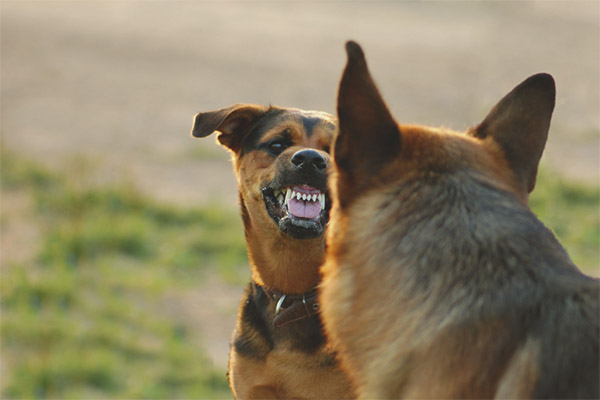The content of the article
Regardless of age, breed, size, the dog must be socialized and not show aggression without reason to people and its relatives. Inadequate pet behavior can harm both other animals and himself. An aggressive dog in pursuit of its fellows can get lost and even get hit by a car’s wheels. How to avoid such disasters? Advice comes from experienced breeders and dog handlers.
Proper control
As a rule, pets are always interested in their fellows. This is especially true of puppies, which are distinguished by activity and curiosity. The owner should not protect his pet from interacting with other dogs, but it is necessary to teach him to communicate gradually. To stop the outbursts of aggression is necessary from an early age. It will be much more difficult to impart the correct manners to an adult dog.
Owners of hunting breeds have a particularly hard time. It is very difficult to control the dog, which is controlled by instincts. Of course, it is possible to solve this question in the simplest way, by putting a leash on a difficult-to-control dog, and not allowing to pounce on other animals. But this will not solve the problem. The best leash should be the control of the owner. There are no dogs that can not be taught to walk on walks properly and adequately treat themselves like. When the dog does not listen to the owner’s commands, it means that the wrong training tactics have been chosen.
It is important to find out the reasons why the dog shows aggressive behavior towards the congeners.
They are as follows:
- lack of communication with other dogs;
- psychological trauma;
- low mental and physical stress;
- mistakes in education;
- sense of dominance;
- competition between individuals of the same sex;
- breed features (for example, fighting).
Discomfort due to pain syndrome (If a good peace-loving dog suddenly began to pounce on its relatives on the street, it should be shown to the vet).
Territorial aggression (following instincts, the dog can attack other animals, at specific territorial sites). Thus, protecting their territory).
Recommendations for learning diplomatic behavior
It is enough to allow your trained pet once to chase another dog, for example, a street dog - and this may become a regularity.
On this occasion, professional dog experts give the following tips:
- A puppy should be allowed to communicate with other individuals, preferably by peace-loving or peers. Of course, new friends must be healthy and vaccinated, and their owners must be credible. Thanks to the communication with his peers, the puppy will develop interpersonal skills. You need to walk your pet more often so that he learns how to react to other dogs, birds, people. For example, you can walk in the private sector, where there may be many irritants. The puppy should hear the voices of other dogs and gradually adapt. You need to start with a short walk, gradually increasing the time until the pet is comfortable.
- If the dog is uncontrollable, and it is impossible to prevent the pursuit of other animals, it is necessary to start training immediately. If an adult dog itself is calm and affectionate, but seeing a kinsman becomes inadequate - it means that strong mistakes were made in the upbringing.
- Before the chase, the dog may show certain signs: pressing his ears, raising his paw, taking a waiting pose, stretching his neck forward or starting to slowly move towards the object of interest. At this moment it is necessary to call the dog and give the command "to me." At the moment when she goes near, but intends to rush to the attack after the object of temptation, you need to command the word "near", while you need to try to get the command to be executed the first time. The animal should approach the foot, and not pay attention to external stimuli. When the team is completed, the pet must be stroked, praised, encouraged by delicacy and continued. After the commands are executed, the pet gradually gets accustomed to diplomatic behavior. If the upcoming attacks do not notice in time, nothing will come of it.
- If the moment is missed, and the dog rushed in pursuit, you need to abruptly say "no," or "near", sharply, but not too much, pull the leash. It is important to show the severity, but in no case is not cruelty. So, over time, the ward will form an adequate perception of other pets.
- You need patience.It is unlikely that the goal of training will be achieved immediately. You need to be prepared for temporary setbacks.
- If the dog has run enough for relatives, and then returned to the owner, you should not immediately praise her. However, it should not be punished. It is necessary to show the client their discontent.
- If, while walking with a leash, the dog behaves approximately, but there are fears that, having been left without him, he will behave in the old way, you need to unfasten the leash and release the dog to run independently. Due to the presence of a leash, it will be easier to catch up with the dog. If it is difficult to catch up, you need to get a leash longer, or a harder collar. This is one of the methods to control stubborn pupils. When the aggressive attitude of the dog towards the fellow is manifested, wearing a strict collar is especially recommended. Canine experts believe that this is much more humane than constant jerking of a regular collar. For small puppies, the use of a strict collar is unacceptable.
Following the above rules will allow you to get the desired result: the diplomatic behavior of the dog.
If self-training attempts were unsuccessful,It is recommended to contact a dog handler.
Video: how to wean your dog to respond to other dogs











To send